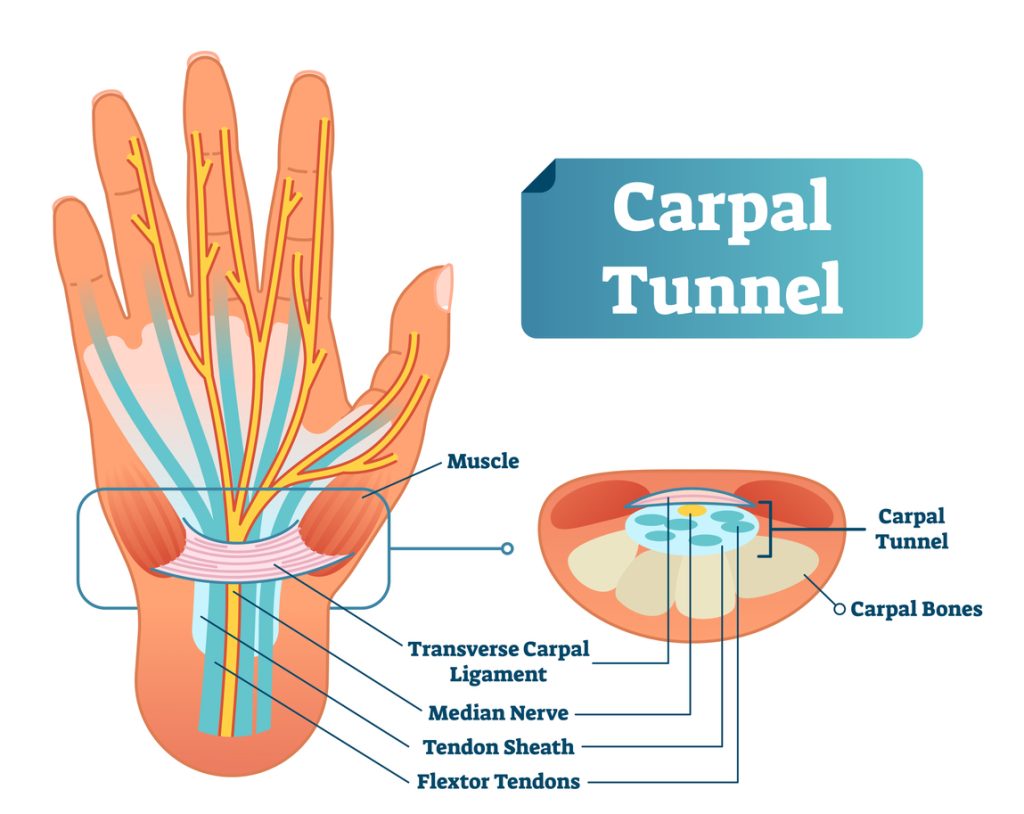Is transcription a “high risk” profession? Most would say no, of course not. Yet, this kind of work carries a considerable—and often overlooked—health risk. Anyone who types on a keyboard for many hours each day, over a long period, is at risk for (if not already suffering with) Carpal Tunnel Syndrome.
In fact, CTS is a surprisingly common problem—perhaps more common than you might imagine. It is among the most common conditions that afflict the nerves of the hand. A 2014 study by American Family Physician estimated that from 3% to 6% of adults in the general population suffer from Carpal Tunnel Syndrome. The numbers are higher among women, with almost 5% of women being afflicted and only about 3% of men.
What is Carpal Tunnel Syndrome?
CTS is a chronic condition in the wrists, hands, and fingers which is characterized by these common symptoms:
- Numbness in the hands or fingers
- Tingling sensation in the hands or fingers
- Weakness and the tendency to lose your grip on or drop objects
- Pain in the hands that often worsens at night
What causes CTS?
It’s important to understand what causes CTS so you can avoid developing it in the first place. Unwanted downtime due to an injury is the last thing you want in an online transcription job where every hour counts.
Pressure on the “median nerve” in your hand causes CTS symptoms. This nerve travels from your forearm to your hand by passing through an opening in your wrist joint called the “carpal tunnel.” Your median nerve shares this space with several tendons and ligaments that control the movement of your hand. There isn’t much room in the carpal tunnel and anything that crowds the space, such as any swelling of the tendons, will place pressure on the median nerve. It is this pressure on the nerve that produces the symptoms of CTS.
These symptoms often occur at night, while your hands are at rest. Symptoms are often felt in the forefinger and/or thumb. One telling sign of CTS is if you feel pain in all your fingers except for your little finger because a different nerve controls the sensation in that finger. When you move or shake your hand, you might feel relief of the symptoms, but in CTS, this is only temporary, as the movement stimulates and “wakes up” the nerve. If this occurs, take it as a sign that you may indeed have CTS.
If you don’t address your CTS, the symptoms can continue to worsen and become chronic. CTS is a nerve-related affliction, so it is important to note that there are always some preceding issues; something that puts pressure on the nerve in the first place. Before having CTS, you may have pain or inflammation that comes from fatigue, another illness, or simply wear and tear from all the typing you do. Your discomfort may not be CTS, but you should take it as a sign to see your doctor.
What can happen if CTS goes untreated?
The good news is that CTS can be treated. However, if you don’t address CTS, it can cause permanent damage to the median nerve. This could result in permanent loss of some function in your hand and threaten your ability to produce an income as a freelance transcriptionist.
In acute cases, there are surgical procedures that can help, but at a minimum, this option will keep you out of work for a significant period.
I don’t have any symptoms. Am I still at risk?
Your biggest potential risk factor, of course, is your job as a transcriptionist! If you do a large volume of typing, this puts you at risk for even simple afflictions like tendonitis, which is a swelling of the forearm tendons from fatigue. This swelling, as described above, can lead to CTS.
But there are additional risk factors as well. If any of these pertain to you as a freelance transcriptionist, your risk could be greater than the general population:
- Previous wrist injury (e.g. fracture or dislocation)
- Gender/age: females 40 to 60 years of age
- Conditions causing fluid retention (such as pregnancy)
- Inflammatory conditions (such as rheumatoid arthritis)
- Other illnesses such as thyroid disorders and kidney failure
What steps should you take to prevent CTS?
There are several “best practices” you can follow to minimize your risk. Much of what we recommend relates to having proper posture and position while you type, so make sure to read our “geared up for transcription” blogs to learn about equipment that helps you get (and stay) in the healthiest position for typing.
Follow these tips to prevent and/or minimize the risk of CTS:
- Maintain proper posture and arm position. Good posture keeps your shoulders relaxed, which helps to keep muscles and tendons in your arms relaxed.
- Keep your wrists at a neutral angle. When typing, your wrists should be bent at no more than a 4-degree angle.
- When holding objects, use your whole hand (not just your fingers). In other words, don’t work your fingers too hard.
- Do stretching exercises for your hands and wrists. WebMD has some good ones here.
- Keep your hands warm—lower temperature can contribute to stiffness of the muscles and tendons.
- If possible, switch hands for repetitive hand movements.
- Mind your general health: Exercise and eat right.
What should I do if I have symptoms?
Having some symptoms does not mean you have CTS. Although, in general, most of the symptoms we discussed are the result of stress or fatigue. It’s a good idea to follow these simple steps to provide relief from any pain or numbness you may be experiencing.
- Take frequent breaks
- Ice your wrists for 10 to 15 minutes, and do it several times a day if you can.
- Try taking non-steroidal, over-the-counter anti-inflammatory drugs to reduce any swelling.
- Wear a wrist splint at night and while sleeping to minimize movement.
Note: None of the steps described above should be considered as an alternative to seeking the advice of a physician. If you are experiencing chronic discomfort and symptoms are getting worse, you should consult your doctor.
As a final note, while we hope this information is helpful to the online transcriptionist community, at the same time it is our sincere wish that you never need to use it. Stay healthy!
We would love your feedback: Do you suffer from CTS? And if not, do you take steps to avoid it? What other challenges do you encounter in your freelance transcription job?



This is an excellent article as always. As a typist of over 30 years, I have always been aware of CTS. I have seen it happen to a few of my friends. I try to give my wrists a rest throughout the day.